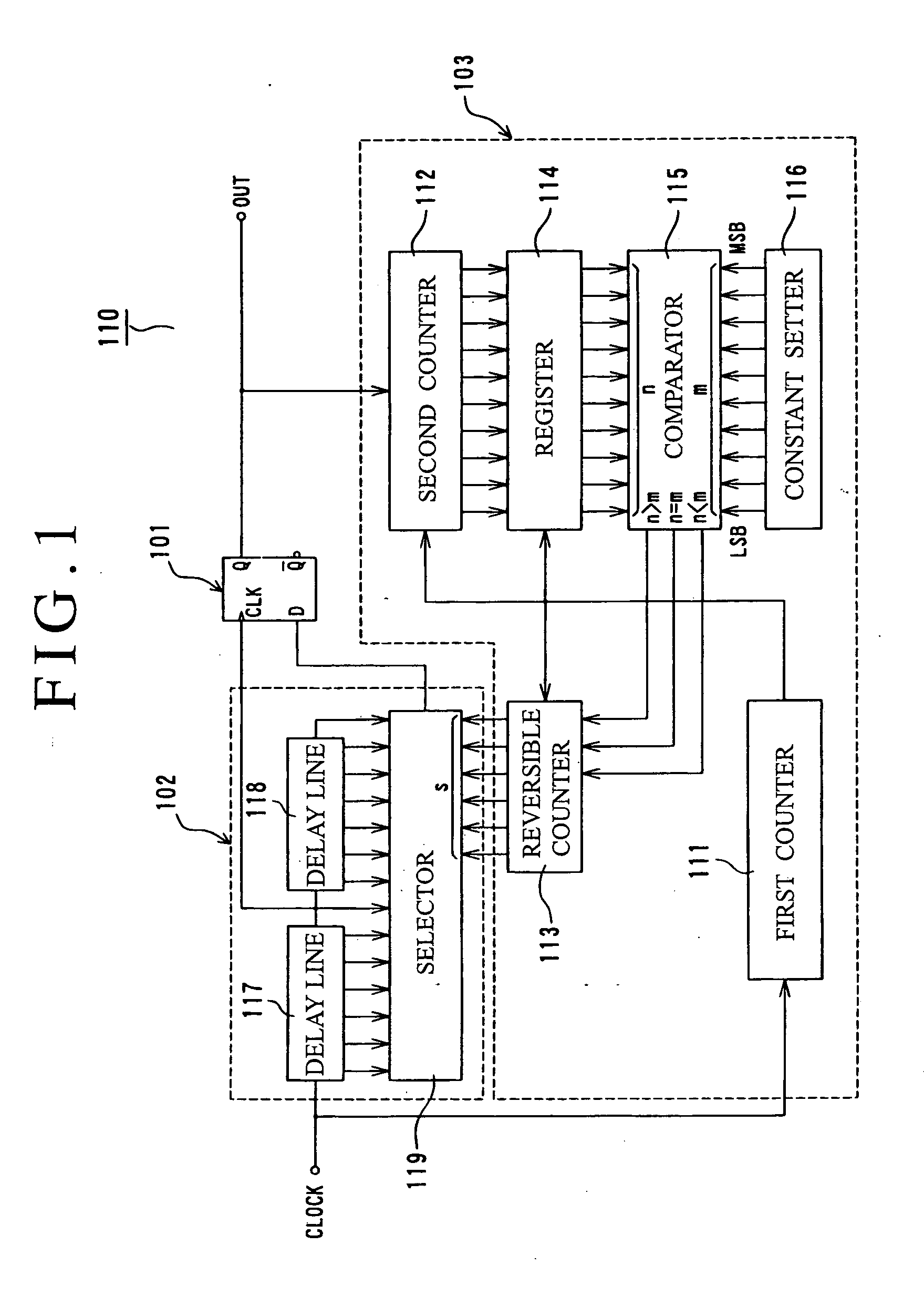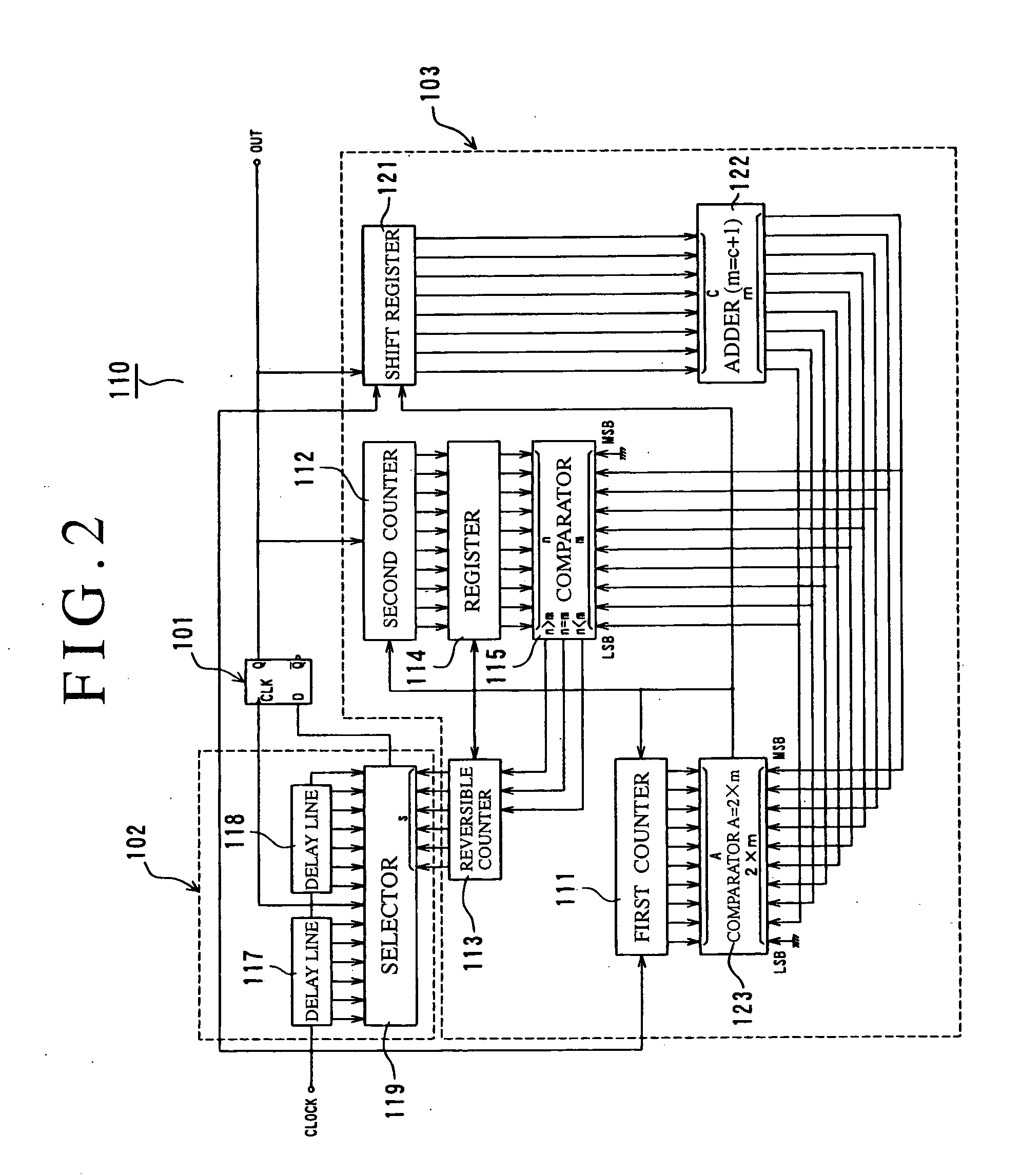Random number generator and probability generator
a probability generator and random number technology, applied in the field of random number generators, can solve the problems of large circuit scale, complex circuit structure, increased expected cost, etc., and achieve the effect of high stability and high performan
- Summary
- Abstract
- Description
- Claims
- Application Information
AI Technical Summary
Benefits of technology
Problems solved by technology
Method used
Image
Examples
first embodiment
[0168]FIG. 1 is a circuit diagram showing a random number generator.
[0169] As shown in FIG. 1, a random number generator 110 of the first embodiment is constituted by a flip-flop 101, a delay unit 102, and a feedback circuit 103.
[0170] Here, a flip-flop having such a function that an output state (0 or 1) becomes definite according to a phase difference between input signals (CLOCK) inputted to two input units can be used as the flip-flop 101, and this embodiment uses a D-type flip-flop provided with a clock terminal CLK and a data terminal D for signal input and shown in FIG. 13.
[0171] Besides, the delay unit 102 includes plural delay output terminals, and is constituted by two delay circuits 117 and 118 (delay line) connected in series to each other, and a selection circuit 119 (selector) for selecting any one of the delay outputs according to a select input. A connection point (which becomes a delay intermediate point) of the two delay circuits 117 and 118 is connected to the c...
second embodiment
[0177] First, the second embodiment shown in FIG. 2 is an example in which instead of the foregoing constant setter 116, a shift register 121, an adder 122, a comparator 123, and the like are newly provided, and a random number sequence outputted every repetition cycle is made setting data (2×m) of a next repetition cycle and comparison data (m) of a comparator 115. Incidentally, the adder 122 adds 1 to a range of output random numbers (0 to m−1) to change it to a range of (1 to m) in order to use the random number sequence as the setting data and the comparison data. Besides, the new comparator 123 generates a repetition cycle (2×m) from count data (A) of the first counter 111 and output data (m) of the adder 122.
[0178] Next, a third embodiment shown in FIG. 3 is an example in which a scramble circuit 124 is added to the second embodiment, and an outputted random number is further scrambled and is used as the setting data and the comparison data. Incidentally, the term “scramble” m...
third embodiment
[0231] Next, a third embodiment in the second mode of the invention will be described.
[0232] As shown in FIG. 44, a random number generator of the third embodiment is constituted by an R-S flip-flop 216 for outputting a one-bit serial random number RND, delay circuits 202 and 203 connected to an S terminal and an R terminal of the R-S flip-flop 216, and a not-shown phase control circuit 205 (see FIGS. 15 and 16).
[0233] Here, FIG. 45 shows an internal circuit of the R-S flip-flop constituted by N-channel MOS transistors and P-channel MOS transistors. An S side NAND gate circuit is constituted by transistors Q1 to Q4, and an R side NAND gate circuit is constituted by transistors Q5 to Q8.
[0234] In an edge trigger type flip-flop such as, for example, an R-S flip-flop, it is known that when a rising phase difference between an S side input signal and an R side input signal is made to approach 0, a metastable phenomenon occurs, and when this phenomenon occurs, it takes a time for a fli...
PUM
 Login to View More
Login to View More Abstract
Description
Claims
Application Information
 Login to View More
Login to View More - R&D
- Intellectual Property
- Life Sciences
- Materials
- Tech Scout
- Unparalleled Data Quality
- Higher Quality Content
- 60% Fewer Hallucinations
Browse by: Latest US Patents, China's latest patents, Technical Efficacy Thesaurus, Application Domain, Technology Topic, Popular Technical Reports.
© 2025 PatSnap. All rights reserved.Legal|Privacy policy|Modern Slavery Act Transparency Statement|Sitemap|About US| Contact US: help@patsnap.com



